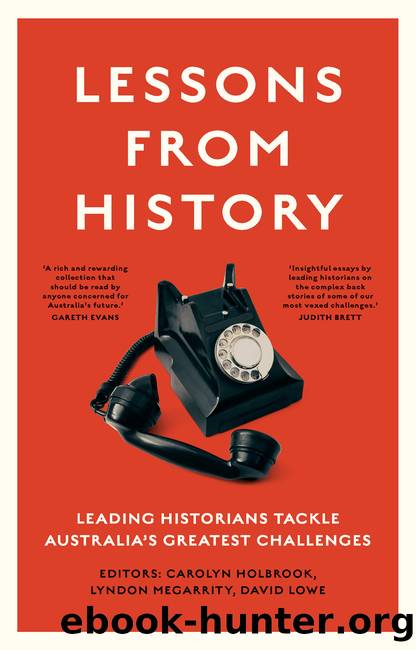Lessons from History by David Lowe

Author:David Lowe
Language: eng
Format: epub
Publisher: NewSouth Publishing
Published: 2022-05-28T00:00:00+00:00
The end of White Australia
In 1945, Australia became a founding member of the United Nations. The Foreign Minister, H.V. Evatt, was elected president of the UN General Assembly in 1948, the same year that the Universal Declaration of Human Rights was adopted.32 From the late 1950s, with Britainâs turn away from its former empire towards Europe, Australian geo-political strategy began a slow reorientation to Asia. These developments compelled Australian policymakers to adjust to an increasingly globalised world that was less tolerant of nations with racially discriminatory practices. Australia could no longer afford to overtly discriminate against nations with whom it sought economic and strategic cooperation.
In 1958, the notorious âdictation testâ was abolished.33 Further, in 1966, Australian Immigration Minister Hubert Opperman âsecured legislation ⦠that allowed for increased migration of skilled non-European migrantsâ, and gave them the right to citizenship after living in Australia for five years.34 As chairman of the Immigration Advisory Council, Sir Keith Wilson pointed out in the House of Representatives on 24 March 1966, âfrom now on there will not be in any of our laws or in any of our regulations anything that discriminates against migrants on the grounds of colour or raceâ.35 Thus, even prior to the Whitlam governmentâs official renouncement in 1973, substantial steps had been taken towards dismantling the White Australia policy. Moreover, large migrant communities from eastern, southern and central Europe and parts of Asia became an increasing presence in Australian society between 1945 and 1972.
A significant step in Australian engagement with its Asian neighbours occurred with the introduction of an innovative educational scheme nested within a bigger cooperative development venture, the Colombo Plan, in 1951.36 Australiaâs scholarships provided under the Colombo Plan were aimed at strengthening relationships with Asia and soon became a useful form of advertising for Australia as an education destination.37 It led to Australiaâs successful international engagement in the region.38 In this era new opportunities opened for Muslim tertiary students who arrived in Australia as early as the 1950s and 1960s from Malaya, Singapore, Indonesia, Pakistan and India.39 Australia attracted foreign students from Iran, Afghanistan and Egypt as well.40 The vast proportion of these were private international students, whose presence ensured the establishment of societies and associations, which had a lasting impact on social and political relations between Australia and its regional neighbours.41
After the White Australia policy was officially abandoned in 1973, bipartisan support emerged for a policy of multiculturalism to replace the old policies of assimilation and integration into a white majority culture.42 The political changes in Australian public policy since the 1950s and seismic shift to multicultural policy since the 1970s altered the nature of migration to Australia.43 With greater cultural acceptance of non-Europeans, the increased migration of Asian and other non-Anglo and white Muslims was now possible. Young Muslims from various parts of the world came to study in Australian universities, and the new era also encouraged general migration of non-Europeans with some assisted programs to Muslim migrants.44 By the 1970s and 1980s, Turkish and Lebanese Muslim migrants were joined by Albanians, Yugoslavians and Cypriots.
Download
This site does not store any files on its server. We only index and link to content provided by other sites. Please contact the content providers to delete copyright contents if any and email us, we'll remove relevant links or contents immediately.
| Civilization & Culture | Expeditions & Discoveries |
| Jewish | Maritime History & Piracy |
| Religious | Slavery & Emancipation |
| Women in History |
Cecilia; Or, Memoirs of an Heiress — Volume 1 by Fanny Burney(32068)
Cecilia; Or, Memoirs of an Heiress — Volume 3 by Fanny Burney(31463)
Cecilia; Or, Memoirs of an Heiress — Volume 2 by Fanny Burney(31413)
The Secret History by Donna Tartt(18188)
Sapiens: A Brief History of Humankind by Yuval Noah Harari(13994)
Leonardo da Vinci by Walter Isaacson(12810)
The Radium Girls by Kate Moore(11627)
Sapiens by Yuval Noah Harari(5125)
How Democracies Die by Steven Levitsky & Daniel Ziblatt(4966)
The Wind in My Hair by Masih Alinejad(4850)
Homo Deus: A Brief History of Tomorrow by Yuval Noah Harari(4692)
Endurance: Shackleton's Incredible Voyage by Alfred Lansing(4513)
Man's Search for Meaning by Viktor Frankl(4295)
The Silk Roads by Peter Frankopan(4275)
Millionaire: The Philanderer, Gambler, and Duelist Who Invented Modern Finance by Janet Gleeson(4108)
The Rape of Nanking by Iris Chang(4024)
Hitler in Los Angeles by Steven J. Ross(3803)
The Motorcycle Diaries by Ernesto Che Guevara(3790)
Joan of Arc by Mary Gordon(3790)
